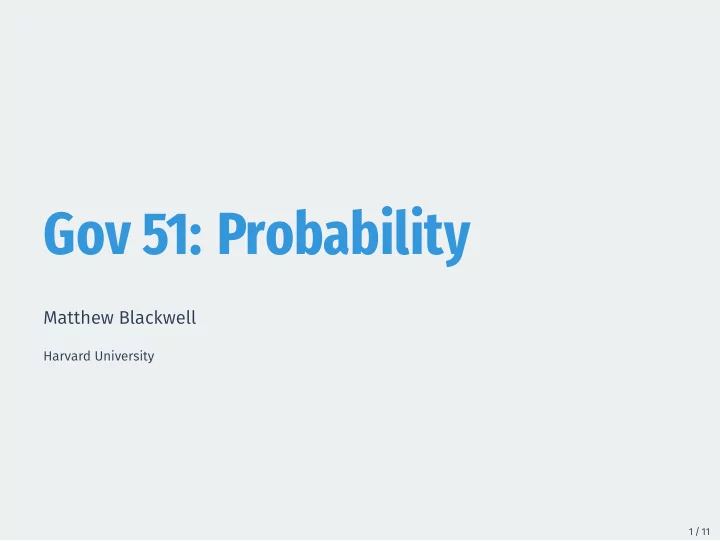

Gov 51: Probability Matthew Blackwell Harvard University 1 / 11
Learning about populations Population Sample probability inference • Probability : formalize the uncertainty about how our data came to be. • Inference : learning about the population from a sample of data. 2 / 11
Why probability? • Probability quantifjes chance variation or uncertainty in outcomes. • It might rain or be sunny today, we don’t know which. • We estimated a treatment efgect of 7.2, but what if we reran history? • Statistical inference is a thought experiments about uncertainty. • Imagine a world where the treatment efgect were 0 in the population. • What types of estimated efgects would we see in this world by chance? • Probability to the rescue! 3 / 11 • Weather changes ⇝ slightly difgerent estimated efgect.
Sample spaces & events • To formalize chance, we need to defjne the set of possible outcomes. • Sample space : Ω the set of possible outcomes. • Event : any subset of outcomes in the sample space 4 / 11
Example: gambling • A standard deck of playing cards has 52 cards: • 13 rank cards: (2,3,4,5,6,7,8,9,10,J,Q,K,A) • Hypothetical trial: pick a card, any card. • Uncertainty: we don’t know which card we’re going to get. • One possible outcome: picking a 𝟧 ♣ • Sample space: 𝟥 ♣ 𝟦 ♣ 𝟧 ♣ 𝟨 ♣ 𝟩 ♣ 𝟪 ♣ 𝟫 ♣ 𝟬 ♣ 𝟤𝟣 ♣ 𝘒 ♣ 𝘙 ♣ 𝘓 ♣ 𝘉 ♣ 𝟥 ♠ 𝟦 ♠ 𝟧 ♠ 𝟨 ♠ 𝟩 ♠ 𝟪 ♠ 𝟫 ♠ 𝟬 ♠ 𝟤𝟣 ♠ 𝘒 ♠ 𝘙 ♠ 𝘓 ♠ 𝘉 ♠ 𝟥 ♡ 𝟦 ♡ 𝟧 ♡ 𝟨 ♡ 𝟩 ♡ 𝟪 ♡ 𝟫 ♡ 𝟬 ♡ 𝟤𝟣 ♡ 𝘒 ♡ 𝘙 ♡ 𝘓 ♡ 𝘉 ♡ 𝟥 ♢ 𝟦 ♢ 𝟧 ♢ 𝟨 ♢ 𝟩 ♢ 𝟪 ♢ 𝟫 ♢ 𝟬 ♢ 𝟤𝟣 ♢ 𝘒 ♢ 𝘙 ♢ 𝘓 ♢ 𝘉 ♢ • An event: picking a Queen, { 𝘙 ♣, 𝘙 ♠, 𝘙 ♡, 𝘙 ♢} 5 / 11 • in each of 4 suits: (♣, ♠, ♡, ♢)
What is probability? • The probability ℙ( 𝘉 ) represents how likely event 𝘉 occurs. • Bayesian : ℙ() are subjective beliefs about outcomes. • Frequentist : ℙ() refmects relative frequency in a large number of trials. • Same math, but difgerent interpretations: 𝟨𝟥 𝟨𝟥 𝟤 • probability of drawing 𝟧 ♣ : • Example: randomly draw 1 card: number of elements in Ω number of elements in 𝘉 ℙ( 𝘉 ) = • If all outcomes equally likely , then: 6 / 11 • probability of drawing any ♣ : 𝟤𝟦 • Not our fjght ⇝ stick to frequentism in this class.
Probability axioms • Probability quantifjes how likely or unlikely events are. • We’ll defjne the probability ℙ( 𝘉 ) with three axioms: 1. (Nonnegativity) ℙ( 𝘉 ) ≥ 𝟣 for every event 𝘉 2. (Normalization) ℙ( Ω ) = 𝟤 3. (Addition Rule) If two events 𝘉 and 𝘊 are mutually exclusive ℙ( 𝘉 or 𝘊 ) = ℙ( 𝘉 ) + ℙ( 𝘊 ). 7 / 11
Gambling 102 • What is ℙ( Q card ) if a single card is randomly selected from a deck? 𝟧 𝟨𝟥 8 / 11 • “randomly selected” ⇝ all cards have prob. 𝟤 / 𝟨𝟥 • “4 card” event = { 𝘙 ♣ or 𝘙 ♠ or 𝘙 ♡ or 𝘙 ♢} • Union of mutually exclusive events ⇝ use addition rule • ⇝ ℙ( Q card ) = ℙ( 𝘙 ♣) + ℙ( 𝘙 ♠) + ℙ( 𝘙 ♡) + ℙ( 𝘙 ♢) =
Useful probability facts • Probability of the complement: ℙ( not 𝘉 ) = 𝟤 − ℙ( 𝘉 ) 𝟨𝟥 • General addition rule for any events, 𝘉 and 𝘊 : ℙ( 𝘉 or 𝘊 ) = ℙ( 𝘉 ) + ℙ( 𝘊 ) − ℙ( 𝘉 and 𝘊 ) • Probability of drawing Queen or ♣ ? • 𝟧 𝟨𝟥 9 / 11 • Probability of not drawing a Queen is 𝟤 − 𝟧 𝟨𝟥 = 𝟧𝟫 𝟨𝟥 + 𝟤𝟦 𝟨𝟥 − 𝟤 𝟨𝟥 = 𝟤𝟩
Conjunction fallacy Linda is 31 years old, single, outspoken, and very bright. She ma- jored in philosophy. As a student, she was deeply concerned with issues of discrimination and social justice, and also participated in anti-nuclear demonstrations. • What is more probable? 1. Linda is a bank teller? 2. Linda is a bank teller and is active in the feminist movement? • Famous example of the conjuction fallacy called the Linda problem. • Majority of respondents chose 2, but this is impossible! • Law of total probability for any events 𝘉 and 𝘊 : ℙ( 𝘉 ) = ℙ( 𝘉 and 𝘊 ) + ℙ( 𝘉 and not 𝘊 ) • ℙ( teller and feminist ) = ℙ( teller ) − ℙ( teller and not feminist ) 10 / 11
Law of Total Probability 0 𝟤𝟣𝟣 𝟬 ℙ( woman ) = ℙ( woman & a Democrat ) + ℙ( woman & not a Democrat ) • What’s the probability of randomly selecting a woman senator? 100 2 53 45 Total Democrats 26 9 17 Women 74 2 44 28 Men Total Independents Republicans 11 / 11 = 𝟤𝟪 𝟤𝟣𝟣 = 𝟥𝟩 𝟤𝟣𝟣 +
Recommend
More recommend